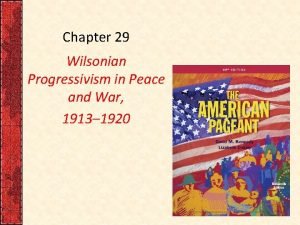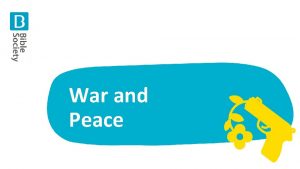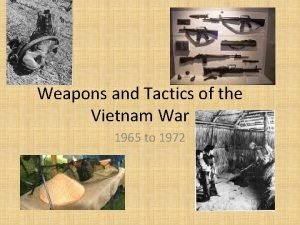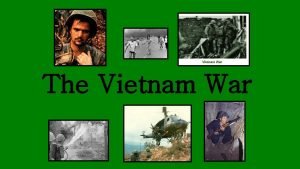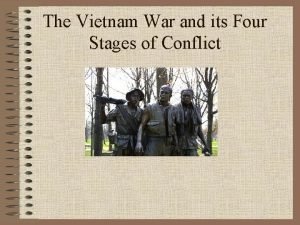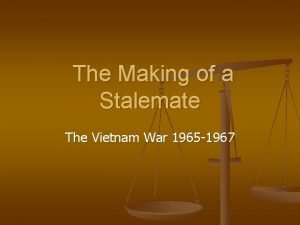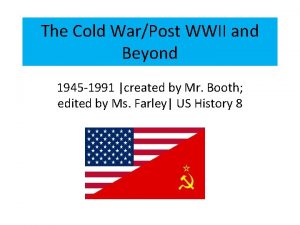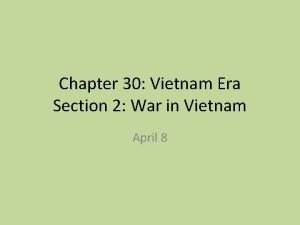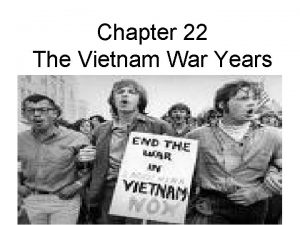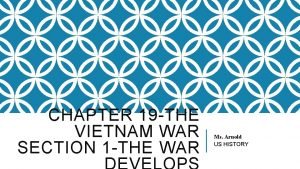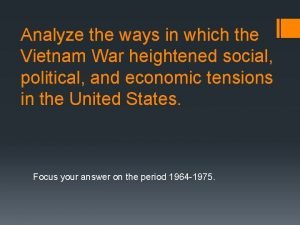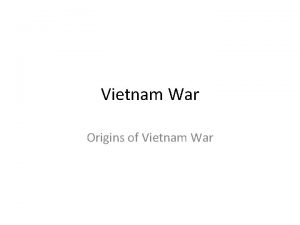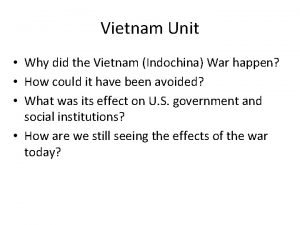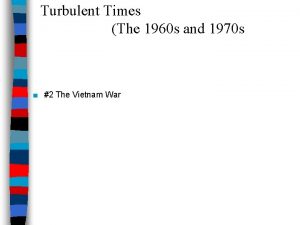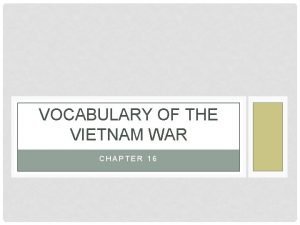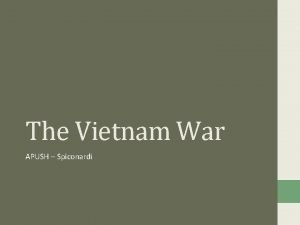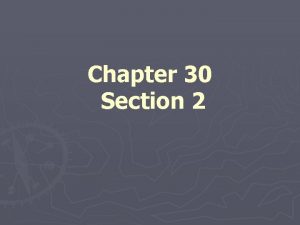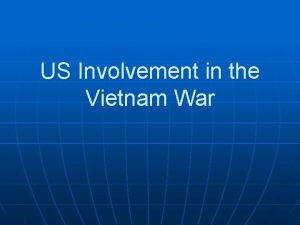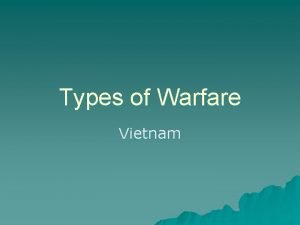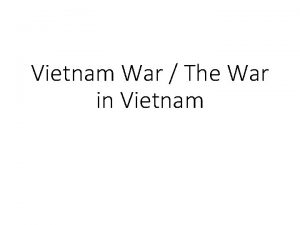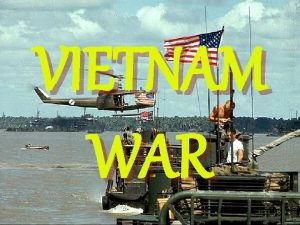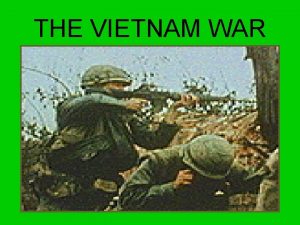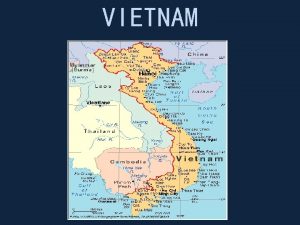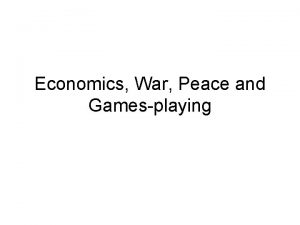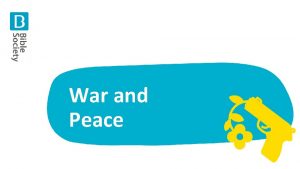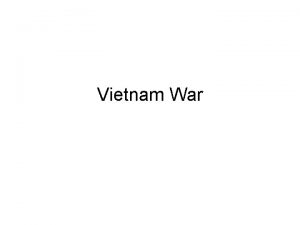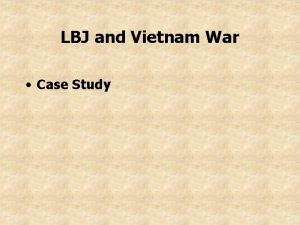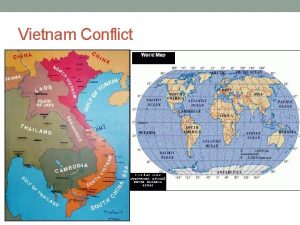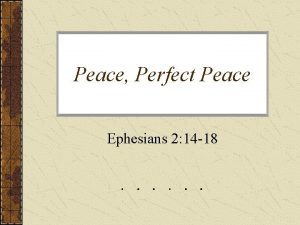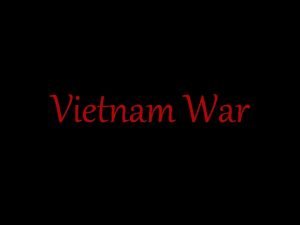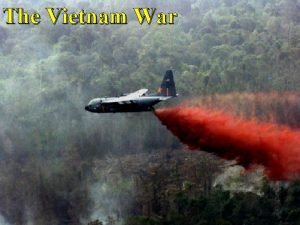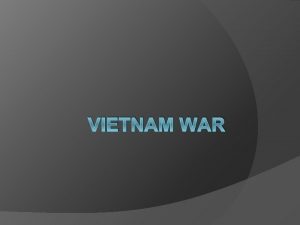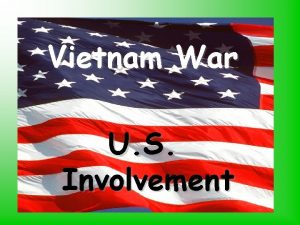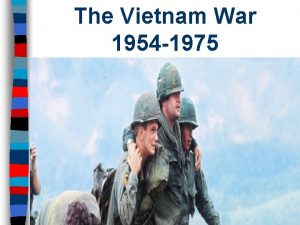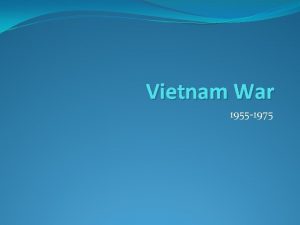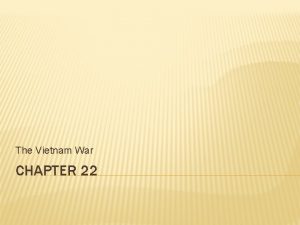Vietnam War Part IV Peace In Vietnam After
























- Slides: 24

Vietnam War – Part IV

Peace In Vietnam • • • After the 1972 election, Nixon escalated bombing of North Vietnam By the end of the year, the western half of South Vietnam was in the hands of the Viet Cong Nonetheless, the bombing forced the North Vietnamese to agree to cease-fire arrangements on January 23, 1973

Peace In Vietnam • Nixon said the cease-fire agreements amounted to “peace with honor”

Peace In Vietnam • In January 1973, the U. S. , South Vietnam, North Vietnam, and the Viet Cong signed a formal agreement in Paris. Among the provisions in the agreement were: – All U. S. forces would be withdrawn – All prisoners of war would be released – An international force would keep the peace – The South Vietnamese would have the right to determine their own future – North Vietnamese troops could remain in the South – The 17 th parallel would divide the country until it

Revelations About Cambodia • After the Vietnam ceasefire in January 1973, Nixon continued large-scale bombing of communist forces in order to help the Cambodian government and repeatedly vetoed congressional efforts to stop him • This caused disorder and civil war

American Withdrawal • • • This did not end the war between North and South Vietnam! Fighting continued as both sides violated the truce In the spring of 1975, North Vietnam began a new offensive against the South

Defeat of South Vietnam • The President was powerless because: – – • • Two years before, Congress passed the War Powers Act, limiting the President’s war powers Ford asked for military aid for South Vietnam, but Congress used the War Powers Act to say no The last American troops were evacuated by helicopter on April 29, 1975 By early May, the South Vietnamese capital of Saigon fell

Vietnam is Finally United • A military government was installed and on July 2, 1976, the country was united as the Socialist Republic of Vietnam • Collaborators with the U. S. either fled or were interned in prison camps

Failures of Vietnam • Couldn’t tell who the enemy was • TV showed atrocities • The government lost the public’s support after lying to them • We underestimated the Vietnamese • We expected the war to be short, so we had no long-term plan • LBJ had to tread carefully or he would lose support for the Great Society

Failures of Vietnam • Civilian government leaders tried to restrain war, while military leaders wanted to expand it • Ho Chi Minh was a good leader; Bo Dai, Ngo Dinh Diem, and other in South Vietnam were bad leaders • Low morale among troops (drug use, fragging); enemy was motivated to win • S. Vietnam army was poorly trained • Didn’t win “hearts and minds” of Vietnamese

Failures of Vietnam • Poor strategies: – Bombing of tunnels and Ho Chi Minh trail – South Vietnamese put in “fortified villages” – Search and destroy didn’t gain territory – Vietnamization didn’t work because the South Vietnamese weren’t trained well enough – Agent Orange, napalm, atrocities didn’t win “hearts and minds” of the Vietnamese people – Lying or hiding things to the public about the war caused discontent

Legacy of the War • • • Longest war Only war the U. S. lost Death estimates: – 58, 000 Americans dead; 300, 000 wounded – 900, 000 North Vietnamese and Viet Cong dead; 2 million wounded – 225, 000 South Vietnamese dead; 550, 000 wounded • The U. S. would spend millions of dollars locating troops MIA or still being held as POWs

Legacy of the War • Spent $150 billion and produced a huge national debt and growing inflation • More bombs fell on Vietnam than had fallen during WWII and the Korean War • Landscape was marred • With the North Vietnamese victory, Laos and Cambodia fell to Communism

Legacy of the War • Millions of Vietnamese (500, 000 went to the U. S. ), Laotians, and Cambodians fled their country by boat to escape communism • American troops were not welcomed home as that had been during WWII • America lost self-esteem, confidence in its military prowess, and economic power


Legacy of the War • There was distrust between the U. S. government and the American people • The war made the U. S. unpopular with Third World states and world public opinion • Vindictive U. S. policy ensured that Vietnam would continue to suffer economically because of a trade embargo

What Happened To Cambodia? • • • In 1975, Cambodia fell to the Khmer Rouge, who are a force of Communists. They were led by a brutal dictator, Pol Pot. They killed anyone remotely suspected of being pro-Western In total, 2 million Cambodians (1/4 of the population) were shot, while the rest died of starvation, disease, or mistreatment in labor camps He was forced from power after a Vietnamese invasion in 1978, followed by a military occupation that lasted for a decade

What Happened To Laos? • • The Pathet Lao (a communist guerilla force) took over They had been given supplies during the war from the North Vietnamese America’s loyal allies, the Hmong, were the victims of Pathet Lao genocide 100, 000 escaped, but another 100, 000 were killed in the genocide

Lessons of Vietnam • • • The difficulties of intervening in a foreign war The pitfalls of incrementalism The perils of underestimating an enemy The U. S. is not all-powerful Of making a commitment it may not be prepared to see through • Fighting to not lose a war, rather than to win

Lessons of Vietnam • The limits of public tolerance for questionable uses of military power abroad • If you are not honest with people in the beginning of the war, you will lose support in the end • Don’t apply some lessons from history to other countries • Don’t go it alone in a war – get support from allies

Lessons of Vietnam • Don’t fight a ground war in Asia because our troops might be outnumbered • Uncensored press can cause problems in a war

Aftermath of Vietnam • • • In 1982, a Vietnam Veterans Memorial was completed in Washington, D. C. to give veterans a sense that the war was worth something and to help heal the wounds of the war In 1994, the U. S. ended an American trade embargo against Vietnam In 1995, the U. S. agreed to restore full diplomatic relations with Vietnam


Aftermath of Vietnam • 10% of the bombs and shells went unexploded • Landmines litter the country • High rates of birth defects developed • Defoliants destroyed 15% of the timber and adversely effected the rice/fish industry
 Description
Description Presidential and radical reconstruction venn diagram
Presidential and radical reconstruction venn diagram After me after me after me
After me after me after me John 14
John 14 Wilsonian progressivism in peace and war
Wilsonian progressivism in peace and war War and peace ending
War and peace ending What does jesus say about war and peace
What does jesus say about war and peace Us weapons vietnam war
Us weapons vietnam war Results of vietnam war
Results of vietnam war Stages of the vietnam war
Stages of the vietnam war Did the vietnam war end in a stalemate
Did the vietnam war end in a stalemate Vietnam war at home webquest answers
Vietnam war at home webquest answers Vietnam war causes
Vietnam war causes The domino theory vietnam war
The domino theory vietnam war Chapter 19 the vietnam war
Chapter 19 the vietnam war Analyze the ways in which the vietnam war heightened social
Analyze the ways in which the vietnam war heightened social Ngo dinh diem pronunciation
Ngo dinh diem pronunciation Vietnam war
Vietnam war Napalm vietnam war
Napalm vietnam war Vietnam war 1960
Vietnam war 1960 Vietnam war vocabulary
Vietnam war vocabulary Vietnam war apush
Vietnam war apush Agent orange and napalm
Agent orange and napalm Vietnam
Vietnam Punji trap victim
Punji trap victim




